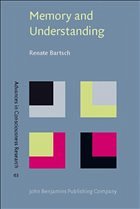Nicht lieferbar

Memory and Understanding
Concept formation in Proust's A la recherche du temps perdu
Versandkostenfrei!
Nicht lieferbar
Main description:This book treats memory and understanding on two levels, on the phenomenological level of experience, on which a theory of dynamic conceptual semantics is built, and on the neuro-connectionist level, which supports the capacities of concept formation, remembering, and understanding. A neuro-connectionist circuit architecture of a constructive memory is developed in which understanding and remembering are modelled in accordance with the constituent structures of a dynamic conceptual semantics. Consciousness emerges by circuit activation between conceptual indicators and episodi...
Main description:
This book treats memory and understanding on two levels, on the phenomenological level of experience, on which a theory of dynamic conceptual semantics is built, and on the neuro-connectionist level, which supports the capacities of concept formation, remembering, and understanding. A neuro-connectionist circuit architecture of a constructive memory is developed in which understanding and remembering are modelled in accordance with the constituent structures of a dynamic conceptual semantics. Consciousness emerges by circuit activation between conceptual indicators and episodic indices with the sensory-motor, emotional, and proprioceptual areas.
This theory of concept formation, remembering, and understanding is applied to Proust's A la recherche du temps perdu , with special attention to the author's excursions into philosophical and aesthetic issues. Under this perspective, Proust's work can be seen as an artistic exploration into our capacity of understanding, whereby the unconscious, the memory, is exteriorized in consciousness by presenting the experienced episodes in the conceptual order of similarity and contiguity through our capacity of concept formation. (Series A)
Table of contents:
- Preface
- I. Introduction: Concept formation, memory, and understanding
- 1. On what there is not
- 2. On what there is
- 3. Memory and remembering
- 4. Understanding
- 5. How memory works in understanding
- II. Memory
- 1. The architecture of memory
- 2. Remembering, structured from out the episodic memory base
- 3. The architecture of remembrance and deficiencies of memory
- 4. The Role of memory in understanding
- III. Concept formation, remembrance, and understanding
- 1. Bergson and Proust.
- 2. Bergson on memory, perception, action, and understanding
- 3. Individual and general concepts in Proust's novel
- 4. The method of the author
- 5. Individual concepts of places and objects
- 6. The Past in the Present
- 7. The aesthetic experience
- 8. The home ground
- IV. Epilogue: The conscious and the unconscious
- References
- Index
This book treats memory and understanding on two levels, on the phenomenological level of experience, on which a theory of dynamic conceptual semantics is built, and on the neuro-connectionist level, which supports the capacities of concept formation, remembering, and understanding. A neuro-connectionist circuit architecture of a constructive memory is developed in which understanding and remembering are modelled in accordance with the constituent structures of a dynamic conceptual semantics. Consciousness emerges by circuit activation between conceptual indicators and episodic indices with the sensory-motor, emotional, and proprioceptual areas.
This theory of concept formation, remembering, and understanding is applied to Proust's A la recherche du temps perdu , with special attention to the author's excursions into philosophical and aesthetic issues. Under this perspective, Proust's work can be seen as an artistic exploration into our capacity of understanding, whereby the unconscious, the memory, is exteriorized in consciousness by presenting the experienced episodes in the conceptual order of similarity and contiguity through our capacity of concept formation. (Series A)
Table of contents:
- Preface
- I. Introduction: Concept formation, memory, and understanding
- 1. On what there is not
- 2. On what there is
- 3. Memory and remembering
- 4. Understanding
- 5. How memory works in understanding
- II. Memory
- 1. The architecture of memory
- 2. Remembering, structured from out the episodic memory base
- 3. The architecture of remembrance and deficiencies of memory
- 4. The Role of memory in understanding
- III. Concept formation, remembrance, and understanding
- 1. Bergson and Proust.
- 2. Bergson on memory, perception, action, and understanding
- 3. Individual and general concepts in Proust's novel
- 4. The method of the author
- 5. Individual concepts of places and objects
- 6. The Past in the Present
- 7. The aesthetic experience
- 8. The home ground
- IV. Epilogue: The conscious and the unconscious
- References
- Index




